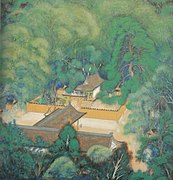Tonouchi Mishō
Tonouchi Mishō ( Japanese 登 内 微笑 , also transcribed Touchi, real first name Shōkichi (正 吉); * February 2, 1891 in Tokyo ; † March 2, 1964 ) was a Japanese painter of the Nihonga direction in the Taishō and Shōwa periods .
life and work
Tonouchi Mishō was born as the eldest son of Tonouchi Hyakutarō (百 太郎). When his mother died in 1896, the father went back to his old homeland in Nagano Prefecture so that the son could spend his youth there. In 1908 Tonouchi Mishō went to Tōkyō and studied painting under Terasaki Kōgyō from the following year . As a painter, he initially chose Kōdō (広 堂) as his stage name.
After Tonouchi had received prizes at exhibitions of the "Bijutsu kenkyū seikai" (美術 研究 精 会), Songakai (巽 画 会) and other prizes, he moved to Kyōto in 1918, where he was mediated by Machida Kyokukō (町 田 曲江; 1879 –1967) was able to continue his education under Kikuchi Keigetsu . In 1920 one of his works was accepted for the first time at the 2nd Teiten exhibition, the series of pictures "„ の 作 "(Nara no saku) with the three pictures" 末 社 の 山 "(Matsusha no yama)," 不退 寺 " (Futai-ji) and "春日 若 宮" (Kasuga-wakamiya). After that he was also successful at the following exhibitions.
From 1922 Tonouchi attended the Kyōto Municipal Art School (京都 市立 絵 画 専 門 学校), from which he graduated in 1925. His picture "歓 喜 光" (Kankikō) submitted to the 6th Teiten exhibition received a special award, as did the picture "多 武 之 峯 春雪" (Tō no mine shunsetsu, spring snow at Tō-no-mine) submitted on the 8th Teiten ). In 1928 he became an advisor for the Teiten. At the “Exhibition of Japanese Painting” in Berlin in 1931 he was represented with the painting “Malvenstaude”. At the Shinbunten he was able to exhibit jury-free, and after the Pacific War also at the Nitten.
In addition to his artistic activity, Tonouchi taught from 1930 to 1945 at the "Municipal School for Art and Applied Arts Kyōto" (京都 市立 美術 工 芸 学校, Kyōto shiritsu bijutsu kōgei gakkō). From 1955 to 1958 he was busy painting sliding doors (襖 絵, Fusuma-e) within the imperial palace complex.
photos
Remarks
- ↑ a b c Teiten ( 帝 展 ) is the abbreviation for the annual state art exhibition ( 帝国 美術展 覧 会 , Teikoku bijutsu-in tenrankai ) between 1919 and 1935. The predecessor from 1907 to 1918 was called Bunten (文 展) for Mombushō bijutsu tenrankai ( 文部省 美術展 覧 会 ), the successor from 1936 to 1944, a shin (新) for “new” was placed in front of it. The successor from 1946, now no longer state-owned, was called Nitten for ( 日本 美術展 覧 会 , Nihon bijutsu-in tenrankai ).
- ↑ Tō-no-mine is a mountain area in the south of the city of Sakurai (Nara) .
literature
- National Museum of Modern Art, Kyoto (ed.): Touchi Mishō In: Kyōto no Nihonga 1910–1930. National Museum of Modern Art, Kyoto, 1986. ISBN 4-87642-117-X .
- Laurance P. Roberts: Tonouchi Mishō . In: A Dictionary of Japanese Artists. Weatherhill, 1976. ISBN 0-8348-0113-2 .
Web links
| personal data | |
|---|---|
| SURNAME | Tonouchi, Mishō |
| ALTERNATIVE NAMES | 登 内 微笑 (Japanese); Tonouchi Shōkich (real name); 登 内 正 吉 (real name, Japanese) |
| BRIEF DESCRIPTION | Japanese painter |
| DATE OF BIRTH | February 2, 1891 |
| PLACE OF BIRTH | Tokyo |
| DATE OF DEATH | March 2, 1964 |


